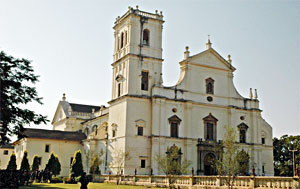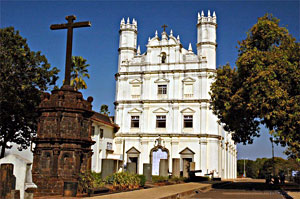|
|
Old Goa Attractions
..................................................................................................
|
|
Tourist Attractions in Old Goa
The main tourist attractions in Old Goa are the churches. Some
famous churches in the Old Goa are Se Cathedral, Chapel of Our
Lady of the Rosary Manueline, Church Of St. Augustine, Church
and Convent Of St. Monica, Basilica of Bom (the Good) Jesus,
Convent & Church Of St Francis Of Assisi, Church Of St.
Cajetan, Arch of the Viceroys, Gate of the Fortress of the
Adil Shah. |
|
|
|
Se
Cathedral
Construction of the Se de Santa Catarina, the largest
church in Old Goa, began in 1562 and though the building
was completed by 1619, the altars were not finished
until 1652. The building’s style is Portuguese-Gothic
with a Tuscan exterior and Corinthian interior. The
remaining tower houses a famous bell, often called the
Golden Bell because of its rich sound. The main altar is
dedicated to St Catherine of |
 |
|
|
Alexandria,
and paintings on either side of it depict scenes from her life
and martyrdom.
Chapel of Our Lady of the Rosary
Manueline
The Chapel of Our Lady of the Rosary belongs to the earliest
period of church building and is described as Manueline. At
the time of the conquest of Goa, Portugal was enjoying a
period of prosperity under King Manuel (1495-1521), hence the
church is known as the Church of Our Lady of the Rosary
Manueline. The architectural style that evolved borrowed from
Iberian decoration, but also included many local naturalistic
motifs as well as Islamic elements, seen on the marble
cenotaph owing to the Hindu and Muslim craftsmen employed. The
church here has a two storey entrance, a single tower and low
flanking turrets. From this site Albuquerque directed the
battle against the Adil Shahi forces in 1510.
Royal Chapel of St. Anthony
St. Anthony was the national saint of Portugal. The Royal
Chapel of St. Anthony was restored by the Portuguese
Government in 1961.
Church Of St. Augustine
The Church Of St. Augustine is now in ruins, except the
enormous 46 m tower that served as a belfry and formed part of
the façade. The church, which once boasted eight chapels, and
convent was constructed in 1602 by Augustinian friars, but
abandoned in 1835 due to repressive policies of the Portuguese
government, which resulted in the eviction of many religious
orders from Goa. The church vault was collapsed in 1842
burying the image, followed by the façade and main tower in
1931.
Church and Convent Of St. Monica
The Convent of St. Monica is the biggest church in East Asia.
This huge square laterite building is three storeys high and
was built around a sunken central courtyard which contained a
formal garden. The construction of this building was completed
in 1627, only to burn down nine years later. Reconstruction
started the following year, and it’s from this time that the
buildings date. The church is in the southern part of the
building. At one time it enjoyed the status of Royal
Monastery, now it is the Mater Dei Institute for Nuns founded
in 1964 for theological studies. Within the convent, the
excellent Museum of Christina Art contains statuary, paintings
and sculptures transferred here from the Rachol Seminary. Many
of the works Goan Christina art during the Portuguese era were
produced by local Hindu artists. |
|
|
|
The
Basilica of Bom (the Good) Jesus
The world famous church or Basilica of Bom Jesus
contains the tomb and mortal remains of body of St.
Francis Xavier, a former pupil of the soldier turned
saint, Ignatius Loyola, the founder of the Order of
Jesuits. In 1541, St. Francis Xavier, was given the task
of spreading Christianity among the subjects of the
Portuguese colonies in the East. St Francis Xavier
embarked on missionary voyages that became legendary
and, considering the state of transport at the time,
were nothing short of miraculous. This basilica is
famous throughout the Roman Catholic world. The focus of
the church is the three-tired marble tomb of St Francis.
His remains are housed in a silver casket, which at one
time was covered in jewels. The Jesuits began work on
the their own church in 1594. By 1605 it was finished
and consecrated. In 1613 the body of St Francis was
|
 |
|
|
brought there
from the College of St Paul. It was moved into the
church in 1624 and its present chapel in 1655 where it has
remained ever since. St Francis was canonized by Pope Gregory
XV in 1622 and in 1964 Pope Pius XII raised the church to a
minor basilica. The order of Jesuits was suppressed in 1759
and its property confiscated by the state. The church,
however, was allowed to continue services. The church is not
white like all the others in Goa. It was originally lime
plastered but this was recently removed to reveal the laterite
base. The granite decorative elements which have always been
unadorned. The façade is the richest in Goa and also the least
Goan in character. There are no flanking towers. It appears
that the church was modeled on the earlier but now destroyed
church of St. Paul which in turn was based on the Gesu, the
mother church in Rome. There is only one tower in the building
and that is placed at the east end, giving it a more Italian
look. On the pediment of the façade is a tablet with I.H.S.
(Jesus in Greek or Laeus Hominum Salvator). Apart from the
elaborate gilded altars, and the twisted Bernini columns, the
interior of the church is very simple. The Tomb of St Francis
Xavier (1696) was the gift of one of the last of the Medicis,
Cosimo Ill, the Grand Duke of Tuscany, and was carved by the
Florentine sculptor Giovanni Batista Foggini. It took ten
years to complete. It comprises three tiers of marble and
jasper, the upper tier having panels depicting scenes from the
saint’s life. The casket containing his remains is silver and
has three locks, the keys being held by the Governor,
Archbishop and Convent Administrator. Every 10 years on the
anniversary of the saint’s death the holy relics are displayed
to the public. The body of St Francis has suffered much over
the years and has been gradually reduced by the removal of
various parts. One female devotee is reputed to have bitten
off a toe and carried it away in her mouth to Lisbon where is
still supposed to be kept by her family. In 1890 another toe
fell off and is displayed in the Sacristy. Part of the arm was
sent to Rome in 1615 where it is idolized in the Gesu. Part of
the right hand was sent to Japan in 1619.
The house for Jesuit fathers
Next to the church connected with it is the house for Jesuit
fathers, a handsome two storey building with a typically
Mediterranean open courtyard garden. It is also built of
plaster-coated laterite, and was built in 1589 despite much
local opposition to the Jesuits. There was a fire in 1633 and
it was only partially rebuilt. It now houses a few Jesuit
fathers who run a small college. There is a modern art gallery
next to the church.
The Inquisition in Goa
In the Palace of the Inquisition, is the splendid hall that
once existed, and where over 16,000 cases were heard between
1561 and 1774. The Inquisition was finally suppressed in 1814.
Beneath the hall were dungeons. |
|
|
|
Convent &
Church of St Francis of Assisi |
|
The
Church of St. Francis of Assisi is one of the most
interesting buildings in Old Goa. The Church and Convent
of St Francis of Assisi is a broad vault of a church
with two octagonal towers, beautifully lit by the sun.
The church interior contains gilded and carved woodwork,
and a floor made of carved gravestones – complete with
family coast of arms dating back to the early 16th
century. The walls around the High Altar are decorated
with paintings on wood depicting scenes from St.
|
 |
|
|
Francis life.
The church was built by eight Franciscan friars who arrived
here in 1517 and constructed a small chapel, which was later
pulled down and the present building was constructed on the
same spot in 1661 and later restored in 1762-5. The style is
Portuguese Gothic. The convent now houses the Archaeological
Museum, which has an impressive range of stone sculptures from
different ages in Goa’s history and some portraits of former
Viceroys.
Church Of St. Cajetan
Convent and Church of St Catejan was built by Italian Friars
of the Theatine order who were sent to India by Pope Urban III
to preach Christianity in the kingdom of Golconda (near
Hyderabad). This church is modeled on the original design of
St Peter’s in Rome and shaped like a Greek cross. The friars
were not permitted to work in Golconda, so settled at Old Goa
in 1640. The construction of the church began in 1655.
The Arch of the Viceroys
The Arch of the Viceroys (Ribeira dos Viceroys) was built at
the end of the 16th century to commemorate the centenary of
Vasco da Gama’s discovery of the sea route to India. His
grandson, Francisco da Gama was Viceroy (1597-160). On the
arrival of each new viceroy this would be decorated. The
ornamentation includes a statue of Vasco da Gama. The arch was
rebuilt in 1954.
Gate of the Fortress of the Adil Shahs
The Gate of the Fortress of the Adil Shah's comprises of a
lintel supported on moulded pillars mounted on a plinth and
was probably built by Sabaji, Hindu ruler of Goa before the
Muslim conquest of 1471. The now ruined palace was occupied by
Adil Shahi sultans of Bijaipur who occupied Goa before the
arrival of the Portuguese in 1510. It then became the Palace
of the Viceroys from 1554 to 1695.
Pilar Seminary
The Pilar Seminary is in the village of Velha Goa, 2 km
inland. This ancient institution was founded in 1613 and was
sited on the top of a hill over a Siva temple, Relics of a
headless Nandi Bull and a rock carving of a Naga serpent were
found. |
|